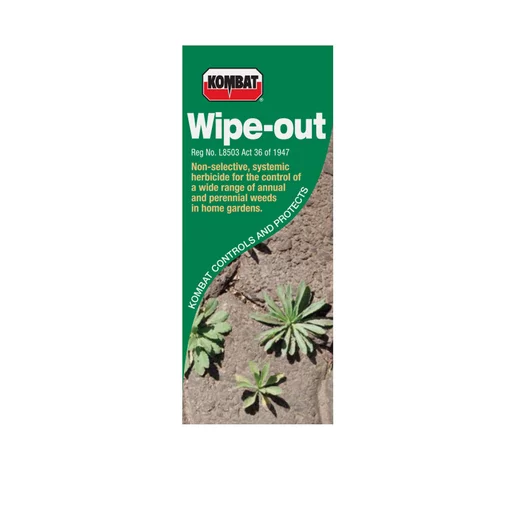Wipe-Out, produced by Dow AgroSciences, is a renowned herbicide widely used in South Africa for effective weed control in various agricultural and non-agricultural settings. Here are 20 important things you should know about Wipe-Out and its application in South Africa:
1. Herbicide Composition
Wipe-Out is a selective post-emergence herbicide containing active ingredients such as dicamba, 2,4-D, and mecoprop-P. These ingredients target broadleaf weeds while sparing most grass species, making it suitable for use in grassy areas.
2. Target Weeds
Wipe-Out is effective against a wide range of broadleaf weeds commonly found in South African crops, pastures, and non-crop areas. It controls weeds such as thistles, dandelions, dock, pigweed, and many others.
3. Application Timing
The optimal timing for applying Wipe-Out depends on the growth stage of the target weeds. It is typically applied when weeds are actively growing and at an appropriate stage for effective herbicidal uptake.
4. Application Methods
Wipe-Out can be applied using various methods, including foliar spraying, spot spraying, and boom spraying. The choice of application method depends on factors such as weed density, target area, and equipment availability.
5. Dosage and Dilution
The recommended dosage and dilution rate for Wipe-Out vary depending on factors such as weed species, growth stage, and application method. It is essential to follow the product label instructions carefully to ensure effective weed control and minimize environmental impact.
6. Adjuvants
The addition of adjuvants such as surfactants or spreaders can enhance the effectiveness of Wipe-Out by improving herbicide coverage and absorption by target weeds. However, it is crucial to use adjuvants approved for use with Wipe-Out and follow recommended application rates.
7. Environmental Considerations
As with any herbicide, it is essential to consider environmental factors when using Wipe-Out. Avoid applying the product near water bodies, sensitive habitats, or areas with endangered plant species to minimize the risk of environmental contamination.
8. Residual Activity
Wipe-Out has limited residual activity in the soil, meaning it breaks down relatively quickly and does not persist in the environment for an extended period. This makes it suitable for use in crop rotation systems and areas where subsequent plantings are planned.
9. Precautions
When handling and applying Wipe-Out, it is essential to wear appropriate personal protective equipment (PPE), including gloves, goggles, and protective clothing, to minimize exposure to the herbicide.
10. Compatibility
Wipe-Out is compatible with many other herbicides and pesticides, allowing for tank mixing to broaden the spectrum of weed control or address multiple pest issues simultaneously. However, compatibility testing is recommended before mixing with other products.
11. Resistance Management
To prevent the development of herbicide-resistant weed populations, it is essential to use integrated weed management strategies, including rotating herbicides with different modes of action and incorporating non-chemical control methods.
12. Regulatory Approval
Wipe-Out is registered for use in South Africa and undergoes rigorous testing and evaluation by regulatory authorities to ensure its safety and effectiveness when used according to label instructions.
13. Product Availability
Wipe-Out is available for purchase through authorized distributors and retailers in South Africa. It is essential to source the product from reputable suppliers to ensure quality and reliability.
14. Storage and Handling
Store Wipe-Out in a cool, dry, and well-ventilated area away from children, pets, and food items. Follow proper storage and handling practices to prevent accidental spills, contamination, or degradation of the product.
15. Packaging
Wipe-Out is typically available in liquid formulation and packaged in various container sizes, including bottles, drums, and bulk containers. Choose the appropriate packaging size based on your specific application needs.
16. Economic Considerations
When considering the use of Wipe-Out for weed control, it is essential to evaluate the cost-effectiveness of the product compared to alternative control methods and weigh the potential benefits against the investment.
17. Training and Certification
Applicators and users of Wipe-Out should undergo proper training and certification to ensure safe and effective herbicide application. Training programs provide essential knowledge on product handling, application techniques, and safety precautions.
18. Record-Keeping
Maintain accurate records of Wipe-Out application, including dates, rates, target areas, and weather conditions. Good record-keeping practices help track herbicide usage, monitor weed control efficacy, and comply with regulatory requirements.
19. Emergency Response
In case of accidental spills, exposure, or other emergencies involving Wipe-Out, follow the appropriate emergency response procedures outlined on the product label and seek medical attention if necessary.
20. Environmental Stewardship
As stewards of the land, it is essential for users of Wipe-Out to prioritize environmental stewardship and sustainable land management practices. Minimize herbicide usage where possible, incorporate non-chemical weed control methods, and follow best management practices to protect natural resources and biodiversity.
By understanding these key aspects of Wipe-Out and adhering to best practices for its use, agricultural producers, land managers, and homeowners can effectively manage weed populations while safeguarding the environment and promoting sustainable agriculture in South Africa.
Join 'Farmers Mag' WhatsApp Channel
Get the latest Farming news and tips delivered straight to your WhatsApp
CLICK HERE TO JOIN






